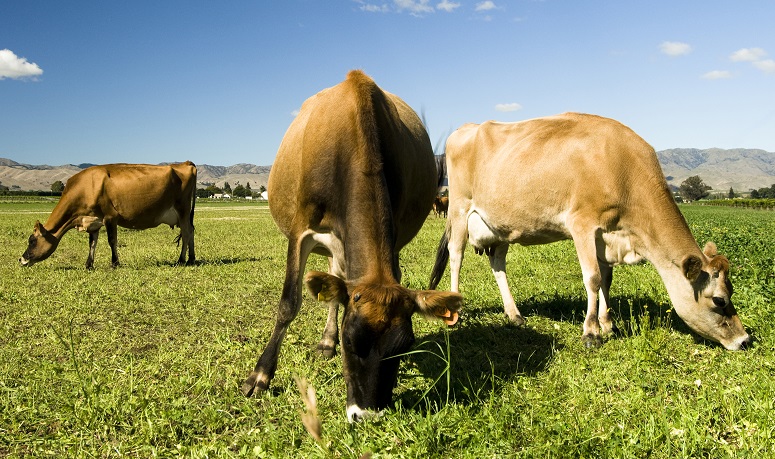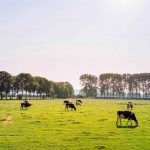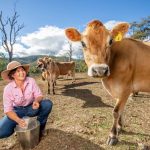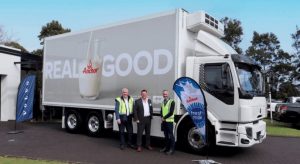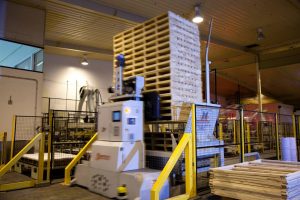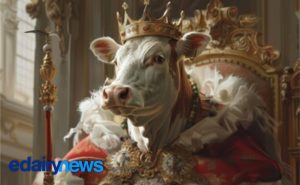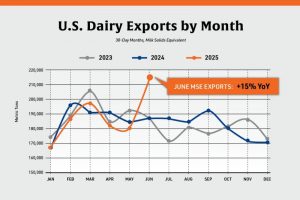
The Quality Hotel Parnell sits atop an Auckland hill surrounded by cafes and boutique shops. Culturally, it’s about as far removed from the bump and grind of dairy farming as you can possibly get in New Zealand. That scenario is about to change as the hotel’s owners, the Norman Barry Foundation, has invested quarter of a million dollars to develop research capability in livestock genetics.
The dairy sector alone contributes $7.8 billion (3.5%) to New Zealand’s total GDP and is New Zealand’s largest export earner. Underlying that economic engine are five million dairy cows on more than eleven thousand farms.
Almost without exception, all of New Zealand’s dairy cows have been genetically selected to be profitable and well-suited for our farming systems and (primarily overseas) market demands.
New Zealand Animal Evaluation Limited (NZAEL) manager, Dr Brian Wickham, says profit can be driven through a range of traits, from a cow’s capacity to produce high levels of milksolids compared to her feed requirements, to meeting animal health needs, to reducing environmental impact and through her ability to get in calf every year.
Genetic gains accumulate like compound interest – every year of selection leads to more profitable heifers entering the national herd. Each year, with the use of artificial insemination, these dairy cows are mated to the best available bulls and their daughters are even more profitable than their mothers. The benefits of genetic gain accumulate over time, but unlike compound interest, they are enjoyed every year.
Annually, the value of this genetic gain is worth around $11 per cow or $4,600 per farm. Summed over all dairy farms and accounting for the additive cumulative effects of genetic gain, New Zealand’s farmers will benefit by around $3 billion over the next ten years.
John Smith, Chairman of the Norman Barry Foundation talks of their support of genetics research.
“ The Foundation Trustees were searching for investments that would have the greatest impact on New Zealand. On the advice of Sir Peter Gluckman, the investment was made to support young scientists that would have the greatest economic benefit for New Zealand. Part of that recommendation was a grant to Massey University’s AL Rae Centre for Genetics and Breeding,’ says Smith.
Smith explains the importance the Foundation puts on future scientists.
“ We specifically directed that the money is to support livestock genetics researchers in their early career by providing them with more than just a stipend. Many of these early-career scientists are fresh out of university with plenty of theoretical knowledge, but limited practical experience. We don’t want to see them ‘locked’ in a university on a low-income scholarship and expect them to transform such a hugely valuable New Zealand industry. That’s why the Foundation supports a top-up to their scholarship, funding to support field work, travel costs to attend conferences and funding to bring global experts to New Zealand as mentors. We see time and again that with a little bit of extra funding, the opportunity for practical experience and connection to an expert mentor, these early career researchers can achieve amazing things. Imagine the value they will bring to New Zealand over the next 10 years.“
After more than a decade in the United States, Professor Dorian Garrick has returned back to New Zealand and take the scientific lead at the AL Rae Centre. Something of a ‘genetic outlier’ himself, Garrick is a recognised leader in animal genetics and his advice has been sought by Governments and private industry world-wide. Garrick, together with a dozen PhD students, postdocs and visiting scientists that have joined him since his return from the United States, is based at the Ruakura Agricultural Campus in Hamilton.
“New Zealand is a great place to do this research because there can be a close link between discovery and implementation,” Garrick said.
Massey University’s Professor Hugh Blair, Co-Director of Operations for the AL Rae Centre, says that the funding provided by the Foundation is unique. The nature of the funding from The Foundation means that Dorian has scientific license to pursue research opportunities that will make the biggest difference for New Zealand. This includes research in beef cattle, sheep, pigs, poultry, deer and forestry. Chief among these opportunities is an opportunity to make a quantum leap in genetic improvement for New Zealand’s dairy cattle herd.
40 million cows … and counting
The New Zealand has a world-class national dairy cattle breeding scheme that has been the envy of many other countries. Production and pedigree records that stretch back many generations, coupled with advanced statistical techniques and a high level of technology uptake by New Zealand farmers all contribute to the national benefit. Underlying this is a core of scientists driving innovation in statistical genetics, genomics and animal science.
The New Zealand dairy industry has performance and pedigree information on close to 40 million dairy cattle spanning back to the 1950’s when performance records were first collected in large numbers.
For the past 70 years, selection based on performance records taken on animals, together with their pedigree records, have driven genetic gain. The key is to pick the genetic outliers, quickly, and use them at a young age to breed the next generation.
Annual genetic gain is driven by four key factors. First, accuracy of selection, which reflects how precisely you can identify genetically superior animals. The more highly heritable a trait is and the more records you have on that animal (and it’s relatives), the greater the accuracy of a selection decision. Second, how intensively you can select the best animals. The ability to select the best bull from a hundred thousand or a million available bulls gives a better shot at picking a genetic outlier compared with picking the best one out of ten.
Thirdly, genetic variation is how much ‘raw material’ you have to work with. The more genetic variation, the better. If there is very little difference between the top and bottom animals, there is little scope to move the population average towards that of the top end. Finally, in a population that’s constantly improving, new genetic outliers will appear each year. If these superior animals can be identified at increasingly younger ages (a decrease in generation interval), the rate of genetic gain each year will go up.
As part of Dairy NZ, New Zealand Animal Evaluation Limited (NZAEL) is tasked with ensuring that the national dairy genetic evaluation optimises genetic gain for the national dairy industry.
Each year, NZAEL estimates the Breeding Worth (BW) of around 300 young bulls who enter a sire-proving scheme. These bulls are evaluated on the merit of their pedigree information and their daughter’s milk production. The success of that scheme has been limited by basic biology, namely waiting for these bulls to be old enough to be mated and waiting again for their daughters to complete their first year’s milking. The resultant five-year lag is a hurdle to improve annual genetic gains.
At the end of those five years, the best 25 bulls (now middle-aged in bull years) are selected for widespread use with artificial insemination enabling this elite team of bulls to produce hundreds of thousands of daughters, and collectively earn millions of dollars for the national dairy industry.
A top bull may have hundreds of thousands of daughters and his influence on the profitability of the dairy sector can be immense. Understandably, there is keen competition among Livestock Improvement Corporation (LIC) and CRV Ambreed, to identify and market semen from the top bulls. The first to identify the next ‘bovine superstar’ can stand to make millions of dollars in sales.
Solutions in the DNA age
Instead of waiting five years to select the most superior bulls, it’s possible to take a blood sample from a young bull calf and directly test his DNA for variations in genes favourable for milk production. This dramatically shortens generation interval and speeds up the rate of genetic gain per year.
Both LIC and CRV Ambreed have invested tens of millions of dollars into their own genomic testing platforms to identify these bull calves, some of which are marketed for widespread use, on the basis of their DNA tests – without having gone through the sire proving scheme. A large part of the value of each company is in the Intellectual property underlying those genomic tests.
A problem that has dogged the New Zealand dairy improvement industry for the better part of a decade is how to make use of LIC and CRV Ambreed’s genomic tests to accelerate genetic gain for all dairy cattle in New Zealand while keeping the genomic information confidential to each company.
Mathematically, Dorian Garrick has proven that the results of LIC/CRV Ambreed genomic data (rather than the underlying data itself), can be combined with the remaining industry records to boost genetic again, and industry profitability, by tens of millions of dollars. This solution may also give dairy farmers greater confidence in selecting bulls that have been evaluated from genomic data.
Richard Spelman, Chief Scientist at LIC says that when applied to real data, this advancement allows New Zealand’s dairy industry to take advantage of the investment that has already been made in existing genomic information.
“Using this data helps keep New Zealand in-step with some other countries that are already making widespread use of DNA-based results,” Spelman says.
Greater use of genomic data means faster genetic gains as well as giving the industry the ability to respond more quickly to anticipated future market demands.
A further benefit is the ability to select, using DNA, for novel traits (i.e. the extremely hard to measure characteristics) that can only be identified via a DNA test. These may include methane emissions per cow or per cow outputs of nitrogen in urine.
The type of funding provided by the Norman Barry Foundation is rare in New Zealand’s science ecosystem. With essentially the only stipulation being ‘get on with job and make a difference for New Zealand’. Professor Garrick has been given scientific license to tackle the big issues first and use whatever resources he sees fit. This ‘open science’ approach is refreshing and is extremely attractive to those working in the industry. It has already attracted top-level science talent to New Zealand and has kick-started the training of the next generation of scientists to take up the kinds of challenges that have broad benefits.
